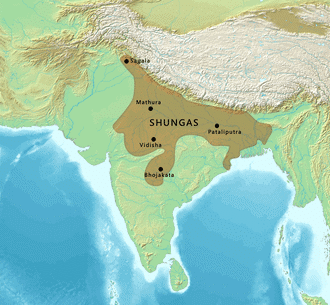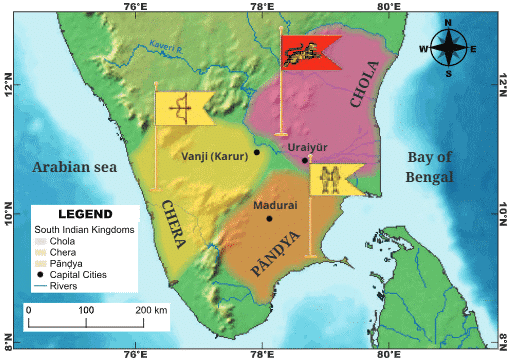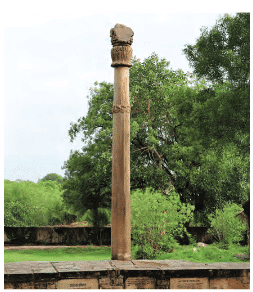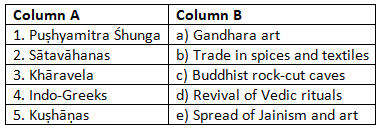CBSE Class 7 Social Science Chapter 6 The Age of Reorganization Worksheet - Free Download
| Table of contents |

|
| Multiple Choice Questions (MCQs) |

|
| Fill in the Blanks |

|
| Very Short Answer Questions |

|
| Short Answer Questions |

|
| Match the Following |

|
Multiple Choice Questions (MCQs)
Q1: What was the main reason for the formation of new kingdoms after the Maurya Empire?
a) Rise of new empires
b) Internal conflicts and invasions
c) Religious conversion
d) Peace treaties
Q2: Who started the Śhunga dynasty?
a) Ashoka
b) Chandragupta Maurya
c) Puṣhyamitra Śhunga
d) Dhanananda
 Shunga Dynasty
Shunga Dynasty
Q3: What was the primary feature of the Śhunga Empire?
a) Large expansion across the subcontinent
b) Promotion of Buddhism
c) Revival of Vedic rituals
d) Invasion of the south
Q4: Which ancient city was the capital of the Sātavāhana dynasty?
a) Ujjain
b) Pataliputra
c) Amrāvatī
d) Kausambi
Q5: What was the primary trade item for the Sātavāhanas?
a) Spices
b) Gold
c) Pearls
d) Textiles
Q6: Which ruler of the Chedi dynasty was a supporter of Jainism?
a) Khāravela
b) Dhanananda
c) Chandragupta Maurya
d) Ashoka
Q7: What was the contribution of the Sātavāhanas to literature?
a) Development of Sanskrit literature
b) Promotion of Tamil poetry
c) Support for Sangam literature
d) Spread of Vedic texts
 Sangam Period
Sangam Period
Q8: What role did the Indo-Greeks play in India?
a) They formed the first Indian empire.
b) They blended Greek and Indian cultures.
c) They conquered all of India.
d) They promoted Hinduism.
Q9: Which famous art styles did the Kuṣhāṇas contribute to?
a) Gandhara and Mathura
b) Ajanta and Ellora
c) Mughal art
d) Rajasthani miniature painting
Q10: Which dynasty ruled parts of south India during the period of reorganisation?
a) Mauryas
b) Cholas
c) Guptas
d) Cheras, Cholas, and Pāṇḍyas
 Chera, Chola, Pandya
Chera, Chola, Pandya
Fill in the Blanks
Q1: The Śhunga dynasty was started by __________, a Mauryan commander.
Q2: The Sātavāhanas ruled the __________ region.
Q3: The __________ caves in Odisha were built by King Khāravela for Jain monks.
Q4: The __________ was a Vedic ritual performed by the Śhunga kings.
Q5: The Sātavāhanas were known for their __________, showing their trade connections.
Q6: The Indo-Greek ruler __________ built the Heliodorus pillar in Madhya Pradesh.
Q7: The __________ dynasty had an empire that stretched from Central Asia to northern India.
Q8: The __________ art style was influenced by the Kuṣhāṇas and mixed Indian and Greek elements.
Q9: The __________ kingdom of south India was known for trading pearls with the Romans.
Q10: The __________ period in south India is known for its Sangam literature.
 Heliodorus Pillar Near Vidisha
Heliodorus Pillar Near Vidisha
Very Short Answer Questions
Q1: Who founded the Śhunga dynasty?
Q2: What were the Sātavāhana rulers known for in terms of trade?
Q3: Which ruler promoted Jainism in the Chedi dynasty?
Q4: Where did the Indo-Greeks establish their presence in India?
Q5: What was the major contribution of the Kuṣhāṇas to Indian art?
Short Answer Questions
Q1: How did the Śhunga Empire influence Indian culture?
Q2: What role did trade play in the Sātavāhana Empire?
Q3: How did the Indo-Greek rulers blend their culture with Indian traditions?
Q4: Why did the Sātavāhanas support multiple religions?
Q5: What was the significance of the Kalinga War in Ashoka’s life?
Match the Following
(Match Column A with the correct option in Column B)

For Worksheet Solutions, go to Worksheet Solutions: The Age of Reorganisation
|
1 videos|107 docs
|
FAQs on CBSE Class 7 Social Science Chapter 6 The Age of Reorganization Worksheet - Free Download
| $1. What is the significance of the Age of Reorganization in history? |  |
| $2. What were the key events that characterized the Age of Reorganization? |  |
| $3. How did the Age of Reorganization impact social structures? |  |
| $4. What role did technology play during the Age of Reorganization? |  |
| $5. How did the Age of Reorganization influence modern governance? |  |















